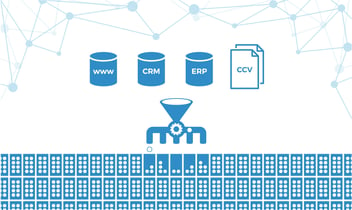We review 4 essential steps to be taken when designing an enterprise data warehouse to ensure its optimal performance.
A poorly designed data warehouse can cause companies to base their knowledge on incorrect data, affecting business performance analysis and promoting poor business decisions. We discuss the 4 essential steps to take when designing an enterprise data warehouse.

As we have mentioned before in this blog, a data warehouse is a type of data management system ideal for storing historical data. Unlike other databases, a data warehouse is specifically designed to promote data analytics and fulfil companies' business intelligence needs.
A data warehouse uses online analytical processing (OLAP) to query data from different sources in order to obtain useful information. The architecture of a data warehouse enables data integration from sales, marketing, customer service, log files, transactions, etc. This 360º view of business activity allows companies to make data-driven decisions, identify areas for improvement and optimise their overall performance.
As a result, more and more organisations are opting to store their data in a data warehouse. In fact, it is estimated that by 2025 the global data warehouse market will be worth $30 billion.
However, a poorly designed data warehouse can have devastating consequences for companies, contributing to poor decisions and affecting the business' growth. A well-designed data warehouse, on the other hand, helps companies make informed decisions based on accurate queries, identify market trends and improve the business performance.
Enterprise Data Warehouse in the Cloud
Recently the cloud has become the preferred environment for data warehousing due to its many advantages over physical data repositories. Cloud data warehousing facilitates the integration of data with other platforms and software, provides higher levels of speed and scalability and requires lower investments, among other advantadges.
Organisations can store their data warehouse in public or private clouds.
A public cloud is a virtualized storage system provided by an external provider. In its data center, the data of many clients is stored —multi-tenancy—, without mutual influence on each other. The optimal and centralised use of the data warehouse translates into cost efficiency.
A private cloud, on the other hand, is a company's own virtualised storage. It has a dedicated data centre (DPC), in whose virtualised infrastructure data is stored and business applications run. In this case, the role of cloud service provider is usually played by the company's TI department.
Private or public cloud servers do not operate as independent systems within structural storage but as a single group of servers. For this purpose, disk space along with other server components (for example, processor or RAM) is virtualized using hypervisors. At the same time, a certain level of abstraction arises with real hardware and virtual storage functions (Virtual Storage), on which the virtual machine monitor VMM (Virtual Machine Monitor), which is also called a hypervisor, runs.
4 essential steps when designing an enterprise data warehouse
1. Define you business requirements
Any data warehouse design project —no matter the size and complexity of the process— will fail if we skip a step or make a mistake in the design discovery phase.
The discovery phase involves analysing the business requirements and needs, taking into account the main tasks that keep the business running smoothly. After all, the goal of a data warehouse is to make it easier for data analysts and decision makers to identify problems and provide the information needed to solve them.
In this sense, the first three phases of data warehouse design —discovery, design and development— require collaborative work between decision-makers and the technical profiles that will develop the data warehouse.
A data warehouse plays a crucial functional role that engages the entire enterprise. In this sense, it is extremely important to ensure that all departments are involved in defining and establishing the business objectives to be met by the data warehouse.
The process is usually controlled by a project manager, who, as an independent specialist, monitors the execution of the project within the allocated budget and corrects the work, taking into account the assigned tasks. The project manager is responsible for the process, milestones and metrics for the successful implementation of the project and collects information from all participants in the process.
Some of the questions we cannot ignore at this stage of the process are:
- What is the purpose and what business objectives we want to achieve through the data warehouse?
- What information should we prioritise?
- Which data sources should we integrate into the data warehouse?
- Do we have a backup system in case our data warehouse fails?
2. Set up a physical environment
A data warehouse needs three separate physical environments: developing, testing and production. When designing the physical environment, it is essential to ensure that each environment has its own server for the following reasons:
- The production area will be really busy, managing the workload efficiently will help prevent your employees from becoming overworked.
- We need a place to test the data warehouse before it moves into production.
- Tests can cause servers to crash and the last thing we want is for the production section to go down.
3. Front-end & queries optimization
Everything covered so far is back-end operations. Once the data warehouse environment has been designed, we can carry out front-end operations so that users can easily access the data.
Some medium-sized companies rely on established BI kits, but other companies may need their own business intelligence tool. In this regard, it is advisable to select specific columns of data rather than an entire spreadsheet and understand the limitations of your OLAP vendor.
4. Roll it out
After resolving the back-end and front-end operations we can launch our data warehouse and start training users.
Training the team that will use the data warehouse is crucial to ensure its smooth operation and the fulfilment of the business objectives for which it has been designed. It is also very important to supervise the operation of the data warehouse and to identify any problems during the first implementation phases.
After successful implementation, day-to-day data management is essential, yet often overlooked in planning and deployment. Not only is it necessary to ensure that regular maintenance (daily, weekly, etc.) of software is carried out, but it is also important to monitor the performance, operation and growth of all systems.
As noted at the beginning of this article, work on a data warehouse is never finished. The data warehouse grows as the number of users expands, new uses for the accumulated data are found, and sometimes new requirements are put forward for obtaining data from the warehouse. Part of the project manager's tasks to be prepared for is ensuring that all systems are fully prepared, preparing updates, and upgrading in the event of operational failure. All problems must be resolved as quickly as possible. It is important to ensure regular backups for data security purposes. In fact, backups must be performed on a strict schedule, and all backups must be verified by sequential database restore in test, development and reporting environments.
Lastly, we must remember that each data warehouse is different and its design must be adapted to the business needs of each organisation. Furthermore, the adaptation and implementation process will also vary according to the particularities of the business environment in which the data warehouse is developed.
Do you need help with the implementation of a data warehouse?
Exclusively written for bismart.com. Prepared by Bailey Hudson | Bailey Hudson is a freelance industrial writer who focuses on quality industrial equipment and modern manufacturing.



